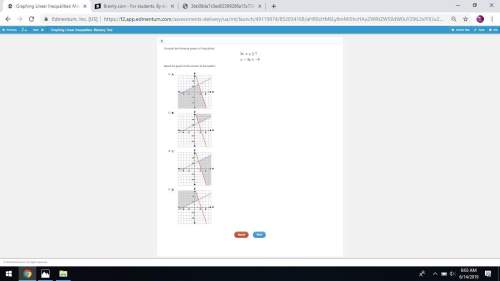
Mathematics, 31.08.2021 21:50 destineenikole175
Four students were discussing how to find the unit rate for a proportional relationship. Which method is valid? “Look at the graph of the relationship. Find the y-value of the point that corresponds to x = 1. That value is the unit rate.” “Look at the graph of the relationship. Count the number of units up and the number of units to the right one must move to arrive at the next point on the graph. Write these two numbers as a fraction.” “Look at the graph of the relationship. Find the x-value of the point that corresponds to y = 2. That value is the unit rate.” “Look at the graph of the relationship. Find two points which have y-values that are one unit apart. The unit rate is the difference in the corresponding x-values

Answers: 1
Another question on Mathematics


Mathematics, 21.06.2019 19:30
Which of the points a(6, 2), b(0, 0), c(3, 2), d(−12, 8), e(−12, −8) belong to the graph of direct variation y= 2/3 x?
Answers: 2

Mathematics, 21.06.2019 21:30
Three friends went on a road trip from phoenix, az, to san diego, ca. mark drove 50 percent of the distance. jason drove 1/8 of the distance. andy drove the remainder of the distance. 1. andy thinks he drove 1/4 of the distance from phoenix, az, to san diego, ca. is andy correct? 2. the distance from phoenix, az, to san diego, ca, is 360 miles. how many miles did each person drive? 3. solve the problem. what is the answer in total?
Answers: 3

Mathematics, 21.06.2019 21:30
In a test for esp (extrasensory perception), the experimenter looks at cards that are hidden from the subject. each card contains either a star, a circle, a wave, a cross or a square.(five shapes) as the experimenter looks at each of 20 cards in turn, the subject names the shape on the card. when the esp study described above discovers a subject whose performance appears to be better than guessing, the study continues at greater length. the experimenter looks at many cards bearing one of five shapes (star, square, circle, wave, and cross) in an order determined by random numbers. the subject cannot see the experimenter as he looks at each card in turn, in order to avoid any possible nonverbal clues. the answers of a subject who does not have esp should be independent observations, each with probability 1/5 of success. we record 1000 attempts. which of the following assumptions must be met in order to solve this problem? it's reasonable to assume normality 0.8(1000), 0.2(1000)%30 approximately normal 0.8(1000), 0.2(1000)% 10 approximately normal srs it is reasonable to assume the total number of cards is over 10,000 it is reasonable to assume the total number of cards is over 1000
Answers: 1
You know the right answer?
Four students were discussing how to find the unit rate for a proportional relationship. Which metho...
Questions

Advanced Placement (AP), 01.07.2021 02:00

Social Studies, 01.07.2021 02:00

Computers and Technology, 01.07.2021 02:00

Mathematics, 01.07.2021 02:00


Geography, 01.07.2021 02:00


Mathematics, 01.07.2021 02:10


Mathematics, 01.07.2021 02:10

Mathematics, 01.07.2021 02:10

World Languages, 01.07.2021 02:10

Mathematics, 01.07.2021 02:10

English, 01.07.2021 02:10

Mathematics, 01.07.2021 02:10

Advanced Placement (AP), 01.07.2021 02:10







